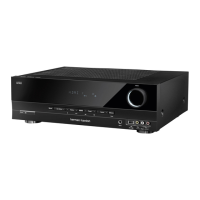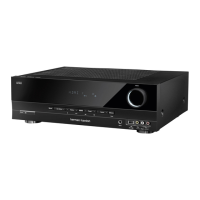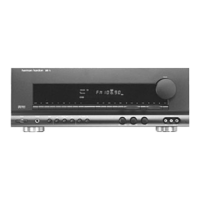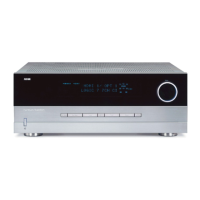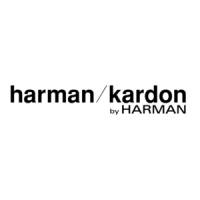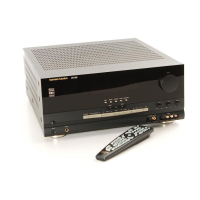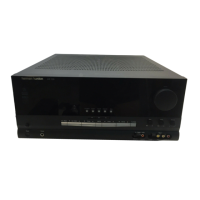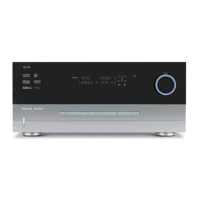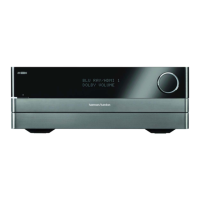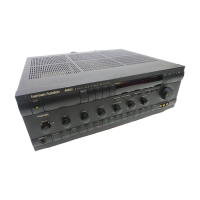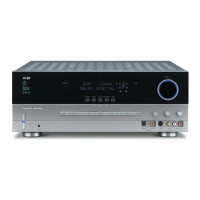OPERATION 31
Operation
6-channel output, the AVR 7000 will automati-
cally sense changes to the bitstream and channel
count and reflect them in these indicators.
The letters used by the Speaker/Channel Input
Indicators
P
also flash to indicate when a bit-
stream has been interrupted. This will happen
when a digital input source is selected before the
playback starts, or when a digital source such as
a DVD is put into a Pause mode.The flashing
indicators remind you that the playback has
stopped due to the absence of a digital signal
and not through any fault of the AVR. This is nor-
mal, and the digital playback will resume once
the playback is started again.
Night Mode A special feature of Dolby Digital is
the Night mode, which enables AC-3 input
sources to be played back with full digital intelli-
gibilty while reducing the maximum peak level
and lifting the low levels by
1
/4 to
1
/3. This pre-
vents abruptly loud transitions from disturbing
others without reducing the impact of the digital
source. The Night mode is available only when
Dolby Digital mode is selected.
The Night mode may be engaged when a Dolby
Digital DVD is playing by pressing the Night
Button
P
on the remote. Next, press the
⁄
/
¤
buttons
6
to select either the middle range or
full compression versions of the Night mode. To
turn the Night mode off, press the
⁄
/
¤
buttons
6
until the message in the lower third of the
video display and the Main Information
Display
W
reads D-Range Off.When the Night
mode is active, the Night Mode Indicator
N
will also illuminate.
The Night mode may also be selected to always
be on at either level of compression using the
options in the Surround Setup Menu. See page
25 for information on using the menus to set this
option.
IMPORTANT NOTES ON DIGITAL PLAYBACK:
1. When the digital playback source is stopped,
or in a pause, fast forward or chapter search
mode, the digital audio data will momentarily
stop, and the channel position letters inside the
Speaker/Channel Indicators
P
will flash.
This is normal and does not indicate a problem
with either the AVR 7000 or the source machine.
The AVR 7000 will return to digital playback as
soon as the data is available and when the
machine is in a standard play mode.
2.Although the AVR 7000 will decode virtually all
DVD movies, CDs and HDTV sources, it is possible
that some future digital sources may not be com-
patible with the AVR 7000.
3. Note that not all digitally encoded programs
contain full 5.1-channel audio. Consult the pro-
gram guide that accompanies the DVD or laser
disc to determine which type of audio has been
recorded on the disc. The AVR 7000 will auto-
matically sense the type of digital surround
encoding used, indicate it in the Bitstream
Indicators
A
and Channel Input Indicators
P
and adjust to accommodate it.
4. When a Dolby Digital or DTS source is playing,
you normally may not be able to select some of
the analog surround modes such as Dolby Pro
Logic, Dolby 3, Stereo, Hall,Theater or Logic 7,
except with special audio tracks (see indication
”AC-3” above) or data format selected (see
”PCM” above).
5. When a Dolby Digital or DTS source is playing,
it is not possible to make an analog recording
using the Tape
‚
and VID 1
h
record outputs,
if the source is connected to any digital input of
the AVR7000 only. But the analog two channel
signal of that source, the ”Downmix” to Stereo
or Dolby Surround, can be recorded by connect-
ing its analog audio outputs to the appropriate
analog inputs (e.g. DVD) of the AVR7000, even if
the digital input of the AVR7000 remains select-
ed. Additionally, the digital signals will be passed
through to the Digital Audio Outputs
‡
.
Tuner Operation
The AVR 7000’s tuner is capable of tuning AM,
FM and FM Stereo broadcast stations and receiv-
ing RDS data. Stations may be tuned manually, or
they may be stored as favorite station presets and
recalled from a 30 position memory.
Station Selection
1. Press the AM/FM Tuner Select button
D
on the remote to select the tuner as an input. The
tuner may be selected from the front panel by
either pressing the Input Source Selector
!
until the tuner is active or by pressing the Tuner
Band Selector
9
at any time.
2. Press the AM/FM Tuner Select button
D
or Tuner Band Selector
9
again to switch
between AM and FM so that the desired frequen-
cy band is selected.
3. Press the Tuner Mode button
E
on the
remote or hold the Band Selector
9
on the
front panel pressed for 2 seconds to select manu-
al or automatic tuning.
When the AUTO indicator
V
is illuminated in the
Main Information Display the tuner will only stop
at those stations that have a strong enough signal
to be received with acceptable quality.
When the AUTO indicator
V
is not illuminated,
the tuner is in a manual mode and will stop at
each frequency increment in the selected band.
4. To select stations press any Tuning button
8
N
. When the AUTO indicator
V
is illumin-
ated, press the button to cause the tuner to
search for the next highest or lowest frequency
station that has an acceptable signal or hold the
button pressed to tune more quickly and release
it to start the auto search. In the Auto mode the
tuner will play each station in stereo or mono
mode, just as the program is transmitted. If the
AUTO indicator
V
is not illuminated, tap the
Tuning button
8
N
to advance one frequency
increment at a time, or press and hold it to locate
a specific station. When the TUNED indicator
U
illuminates, the station is properly tuned and
should be heard with clarity.
5. Stations may also be tuned directly by pressing
the Direct button
K
, and then pressing the
Numeric Keys
G
that correspond to the sta-
tion’s frequency. The desired station will auto-
matically be tuned after the latest number is
entered. If you press an incorrect button while
entering a direct frequency, press the Clear but-
ton
L
to start over.
NOTE: When the FM reception of a stereo
station is weak, audio quality will be increased
by switching to Mono mode by pressing the
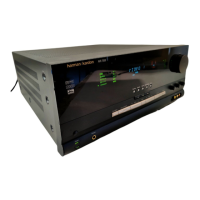
